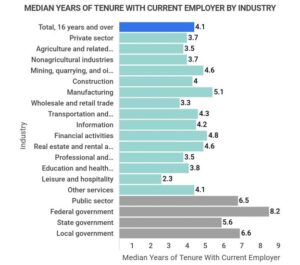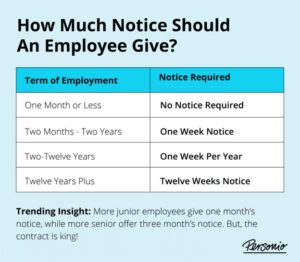It’s been said that no one likes change except a baby with a wet diaper, but change can be good. According to the latest available data, the average person changes jobs 12 times in their lifetime. It’s even more frequent for the hospitality industry: workers stay on average 2.3 years before changing.
The word “quitting” has a bad connotation to it. When changing jobs, consider that you are starting anew, sharing your expertise with another employer. But when you leave, you want to do it the right way in order to keep your stellar reputation intact.

Breaking Up is Hard to Do
Leaving an employer is not an easy thing to do. If you’ve been on the job for a considerable amount of time, leaving can be a tough decision. An employee with five or more years on the job has established some roots there. They’ve also found some comfort in a regular routine, mingling with coworkers, and establishing a baseline of performance. But if another, better position becomes available, it’s understandable to most employers why you are leaving.
You may think you’ve been very subtle about interviewing elsewhere, but don’t be fooled. Most of the time the employer senses what is going on. Announcing that you are leaving may not come as a shock to them so don’t sweat it. Besides, it’s your future at stake and you have a valid reason for leaving. Changing jobs is becoming an acceptable and expected event. Recent research found that, especially among millennials, 64% of workers believe job-hopping to be an acceptable, even beneficial, practice. The key is that regardless of the reason for leaving, always be professional and courteous.
The Two Weeks Notice
Putting in your two weeks’ notice means you’re informing your current employer that you’ll be leaving your job. This notice is typically given at least 10 business days in advance. Not every employer requires a two-week notice, but it’s been a common practice for decades. Usually employees give two weeks’ notice and the employer makes arrangements, adjustments, conducts an exit interview, and collects company property. In the past, it’s been more of a courtesy than a requirement.
But be careful. Check your employee handbook to make sure your employer doesn’t require a two week or other kind of notice. It’s difficult to pinpoint exactly when the two week notice was introduced. It is thought that it originated in the 60s or 70s, at a time when growth in big business was exploding. It is known that the two week notice was to allow the employer time to replace the voided position. When an employee was going to leave the employer, they would make their new start date two weeks out.
The concept was a good one if the departing employee had good standing with the company. The thought was that this good employee would work for the next two weeks as they have in the past. Today, many companies are opting for letting the employee leave on the day of the announcement. That’s because some employers are concerned about the possible lack of performance within the two week period. Or worse, what damage the employee might do in two weeks.

Have a Plan in Place
The two week notice is the most common notice to give, but some organizations prefer you give them longer notice. But some may not require any notice at all. Others may ask you to train the person taking your place. If you’ve been a good employee and have respect for your employer, your departure should be a smooth transition. And you should help to make it that way. Before you give your notice of leaving, make a plan of how you will handle the transition.
This plan should include the following six steps:
1. Don’t share your resignation decision-Keep your plan under raps until you can officially announce it to your supervisor.
2. Prepare your letter of resignation-Take your time to write your letter of resignation and proof-read it several times. Make sure it looks and reads professionally. Don’t shilly-shally or make it too wordy. Just crisp, professional, kind, and to the point. You can find hundreds of templates you can use online for your letter of resignation if you need some guidance. One page should be sufficient. You will want to indicate when you will leave and appreciation for the opportunity they gave you.
3. Think about what you will say-Practice what you will say to your manager several times. When you meet with them to give them your letter, you want it to be a pleasant experience for everyone. You want to leave a long-lasting impression of confidence and professionalism.
4. Speak to the person in charge-Schedule a time to speak with your manager or supervisor about your resignation. Some people have found that doing this on a Friday helps you to feel better over the weekend. You’re not worrying about it and if it went well, you can probably actually celebrate. But don’t make Friday a rule cut in stone. You also have to consider your manager’s schedule and the time and day that is convenient for them.
5. Reach out to clients-If your job was dealing with customers, vendors and contractors, contact them to let them know you will be leaving. If you feel it is beneficial, let them know where you will be working. Also, let them know how much you appreciated them and that you enjoyed working with them. You never know when your paths may cross again and it’s always a good idea to keep some doors open.
6. Reach out to co-workers-These are people you worked with and who you’ve probably created a lasting bond and friendship. Let them know of your departure and share any new contact information. As with your employer, vendors, and customers, your co-workers will remember you. They can impact your future with the words they use to describe you to others.
Be Prepared for Future Changes
As with all big things in life, you really want to have all your ducks in a row when you leave your employer. That means having a plan to sharpen the skills you need, and making sure your resume is up to date. It can be exciting moving on to a new job, but prepare as if you’re looking for your next one. This is a positive mindset to have. Your new job may be the one you keep forever, and that’s wonderful! But preparing for the next one does two things.
First, it gives you hope and helps you look at all possibilities. The second thing is that it keeps you in tune with your strengths and weaknesses. When you review your resume, you can see where you shine and where you might have some work to do. Since you are making sure you don’t burn any bridges when you resign, perhaps you can add more references. The employer you are leaving may be more than happy to give you a great reference.
Use this preparation time to send out “Thank You” letters to your former employer. Send some also to your clients and co-workers. Handwrite these letters and show your appreciation in helping with a smooth transition to your new position. Let them know that if you can be of assistance to them in the future, you will be there. Don’t use the “Thank You” letters to let them know about products or services your new employer offers. That just lacks class. You can do that another time. For now, you are letting them know how much they mean to you.
Keep the Bridge Open and Use It
Getting your resignation notice period out of the way will help relieve the tension you may be feeling about leaving. It will also allow you to move forward with the transition to your next opportunity. Your goal with your two week notice is to make the event count. The way you handle it will follow you always. Slamming your former employer to others and bashing those you worked with is a sure way to burn bridges down. Instead, do everything you can to keep bridges intact. If you have any harsh feelings, keep them to yourself. As Ben Franklin once said, “I shall speak ill of no man.” Embrace that mantra.






